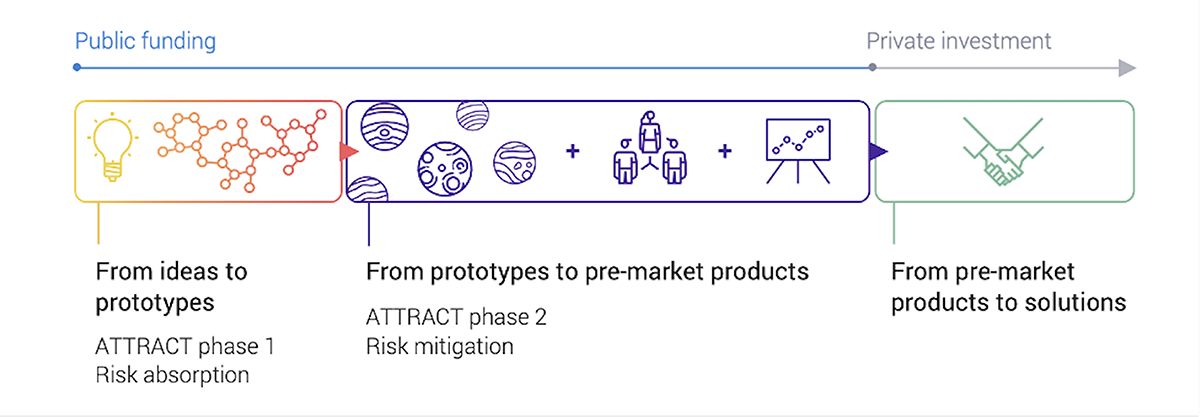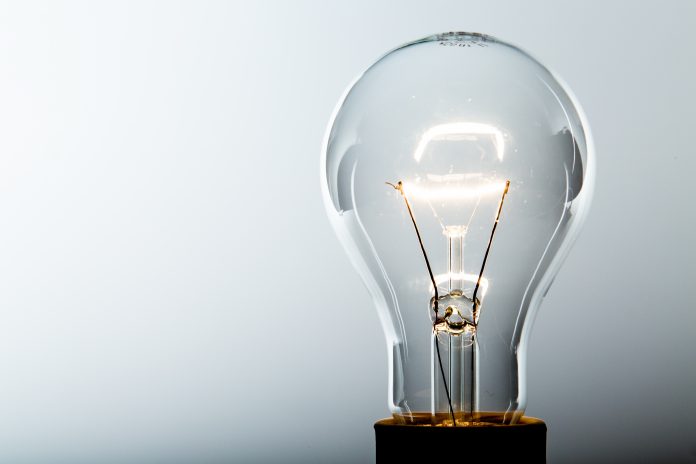Sergio Bertolucci, Chair of the ATTRACT R&D&I Committee, discusses his final remarks on the ATTRACT funding for innovation
After the successful completion of Phase 1, where 170 promising projects have been each awarded €100K to develop a proof-of-concept in 12 months, an open thematic call was launched in mid 2021 (Phase 2) to take forward the most promising opportunities generated in Phase 1 across 9 themes, with a total funding of €25M. In the ATTRACT philosophy of a staged management of risk, Phase 1 was essentially dealing with risk absorption, while Phase 2 is meant to provide a tool for risk mitigation, in consideration of the higher Technical Readiness Level (TRL) expressed by the projects (see figure below).
In order to further improve the process, the call had two submission modalities
Modality A: Demonstrator (up to 500,000 Euros)
Proposals in this modality, at a TRL of 3 or higher at submission time, should prove to be capable of reaching at the end of the project a TRL of 5 or 6, understood as:
- TRL 5 – technology module validated in relevant scientific and industrial environment(s).
- TRL 6 – technology module demonstrated in relevant scientific and industrial environment(s).
Modality B: Industrial System (up to 2,000,000 Euros)
Proposals in this modality, at a TRL of 3 or higher at submission time, should prove to be capable of reaching at the end of the project a TRL of 7 to 9, understood as:
- TRL 7 – system prototype demonstration in a real case operational environment.
- TRL 8 – system complete and scientifically and industrially qualified.
- TRL 9 – actual system proven in operational environment.

Applicants to the Modality B are required to describe their foreseen pathway to market, the resources dedicated to this goal, which must be complementary to the funding received from ATTRACT, as well as the estimated timeline.
Eighteen projects (out of 68 submitted) have been funded, 7 in modality A, 11 in modality B. We have observed a large confluence among the 170 projects of Phase 1 as well as the influx of external industrial partners in most of the proposals.
All the projects have signed their Third-Party Project Agreement with the EU Commission and have already started their 26-month endeavour, as testified by the recent kick-off meeting on May 31.
Testing the vision of ATTRACT innovation
As in the case of Phase 1, which provided a great quantity of invaluable data and insight to test our assumptions, we expect to learn a lot from the evolution and the outcome of Phase 2, which eventually will be the culminating experimental test of the ATTRACT vision.
In the previous articles I have also addressed the potential integration of ATTRACT into the EIC Pathfinder in terms of the governing structure, funding dynamics and potential entry points for private investment. The main conclusions are as following:
- The integration of the ATTRACT governing structure into the EIC as a running funding instrument would not require drastic changes with respect to the current framework.
- The phase-based funding approach of ATTRACT could enhance the quality of the projects funded within the EIC with respect to their breakthrough innovation potential.
- This phase-based funding approach could offer an incentive for investors in the EIC Accelerator, since during ATTRACT Phases 1 and 2 the inherent risk of breakthrough technologies or deep tech is absorbed and mitigated using public funding.
- ATTRACT has the potential for enabling a diversity of entry points for private investment within and outside the EIC Accelerator. Moreover, it can connect the R&D&I agendas with national funding programmes or existing schemes such as EUREKA and Eurostars.
I have also briefly addressed the possibility of translating the ATTRACT funding approach on a national level, to be then implemented through national funding agencies. The main conclusions of these exploratory considerations are the following:
- The deployment of a funding instrument like ATTRACT would not require drastic changes in its governing structure and it could be integrated into existing National funding agencies structures.
- Its deployment could represent a hands-on opportunity for aligning R&D&I agendas between the EC and the National funding programmes, as well as the possibility for providing funding opportunities for excellent projects that otherwise would not be realised.
- It could enable the strengthening of existing national and regional specialised technology clusters and channelling of private investments.
- It could enable to retain young talent at regional level that otherwise would look for developing opportunities somewhere else.
- It could prove being an instrument supporting existing EC initiatives for closing the innovation divide across European Member States. Finally, in the name of all the members of the ATTRACT Consortium, I would like to thank the support received from the European Commission for the funding of ATTRACT Phase 1 and Phase 2 and for its strong support during the execution of the project.
I would also like to thank the ATTRACT community and in particular Markus Nordberg, Pablo *Garcia Tello, Jonathan Wareham for having provided invaluable insight and a lot of material.
*Please note: This is a commercial profile
© 2019. This work is licensed under CC-BY-NC-ND.











